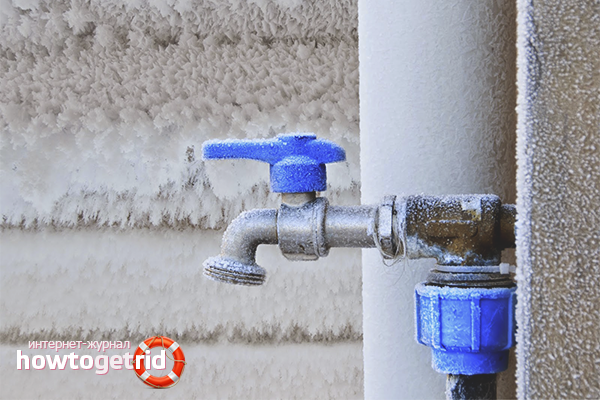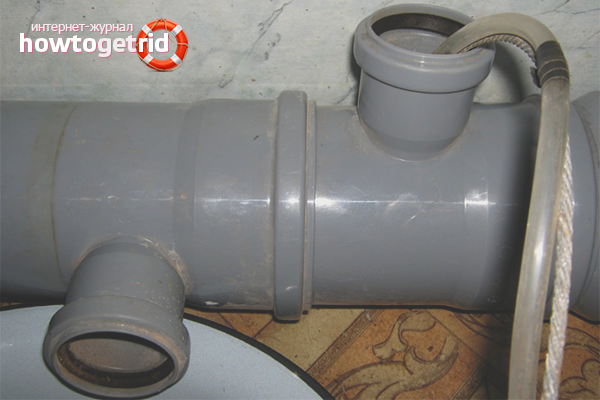The content of the article
If the water supply is improperly installed in a private house, you may encounter the fact that during the frosty season the pipes will freeze. And if this happens in the outer part of the pipe, it is not difficult to eliminate it. But if the pipe is frozen underground, then much more effort will already be required. Only effective ways to combat this problem will be described below.
Classic method
You can not invent various ways and go to the classical method. That is, take a shovel and dig a pipe. After that, you should warm it up and ready. There are several ways to melt ice: you can use a hairdryer (preferably a construction one), a blowtorch, or boiling water. When using hot water, the pipe should be wrapped with rags.
Despite the fact that the method is quite straightforward, only a few use it. The fact is that such a method of eliminating ice in a pipe is extremely inconvenient and has the following disadvantages:
- If the pipe is deep enough (but, unfortunately, not so much as not to freeze), it will take a lot of time to dig it, since frozen soil will not give up just before a regular shovel.
- If you do not know the exact place of freezing, you will have to dig the whole pipe, which, of course, does not inspire optimism.
Those who do not want to spend the whole day (or even more) in the cold and with a shovel in their hands can use the following methods, which are more effective and efficient.
Option for metal pipes
If the water pipes are made of metal, ice plugs can be removed using a two-core copper cable. However, the most important rule in carrying out such work is to comply with safety regulations. In addition, if there is no similar experience in handling electricity, it is better to entrust the matter to a more qualified craftsman.
So. To begin with, you should strip the veins. Each of them should be wrapped around the axis and make 2-3 turns. It is important that the parts of the wire do not touch each other. After that, this side of the wire is introduced into the pipeline. It should be promoted to the freezing point. Accordingly, you should stock up on a long cable.
When a plug has been detected, an electric current is applied to the outer end of the wire. After that, the cable starts to warm up. Thus, the ice inside the pipe also begins to melt. However, the farther the plug is, the longer it will take to fix it.
It is also equally important to pump out melt water. Otherwise, it will certainly freeze again.
A similar method is only effective for the owner of metal pipes. The idea to melt a plastic water pipe in this way, unfortunately, will be doomed to failure. However, there is a way out, and it will be described later.
Removing ice plugs in plastic pipes
The essence of this method is to supply hot water directly to the freezing point of the pipe. However, if you simply pour boiling water, the cork will not go away, and the time and effort spent will be in vain.
In order for the procedure done to give a positive result, you will need:
- Shlan and a large tank with hot water. Congestion can be quite far, so you should stock up on plenty of fluids.
- Compressor. This tool is a must. It is thanks to him that water will enter the pipe quickly enough that will not allow it to cool. In addition, strong pressure will more effectively affect the ice plug. This, in turn, will help to quickly resolve the problem.
The principle of operation of such a device is quite simple. The hose is held through the pipe all the way to a frozen place. Then, water is supplied through the compressor.Once again, it should be noted that water should not be spared. It is worthwhile to prepare a large container with liquid in advance.
How to avoid freezing
To avoid re-doing the above procedures, you should take care of the correct installation of the water supply. After all, it’s better to dig it out and fix all the flaws, than to remove traffic jams from frozen water from year to year. Better yet, if you stumbled upon this article before starting to lay the water supply.
So, first of all, it is worth taking care of the correct laying of pipes. Ordinary plastic household pipes cannot be compared with main pipes through which large volumes of liquid continuously pass. Therefore, they should be buried below the level of soil freezing. Better yet, do not spare money, and entrust the procedure to professionals who, during work, will take into account all the nuances.
You should also take care of warming. Provide thermal insulation underground in the following ways:
- The pipe can be wrapped with basalt and secured with tape. Top, as a heat-insulating material should be laid roofing material.
- You can also use regular polystyrene with cut edges for joints. Wrap it with tape with glued waterproof glue.
- The most reliable, but at the same time the most expensive way of warming the water supply is considered to be winding with a heating cable. If such a method of warming is used in a country house where no one constantly lives, the depth of the trench should be at least 2 meters. If the house is constantly living, a half-meter pit will be enough.
It is worth noting that the latter method is better to use in areas with a small water supply. Then the amount that the installation of the cable will cost will be much lower than laying it through a multi-meter section. In addition, the amount of energy consumed will be no more than 20 watts.
The above tips, when used correctly, will certainly cope with the task. However, it is better to take care of the proper installation of water pipes. Especially underground, since on the surface (in the house or basement) it is much easier to cope with an ice jam.











Submit